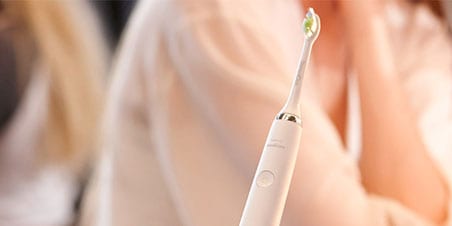
What happens if you don’t brush your teeth?

Maintaining good oral hygiene is crucial for a healthy smile, but cleaning in-between teeth is often overlooked. In addition to regular brushing, flossing plays a significant role in removing plaque and preventing gum disease. While traditional flossing is effective, there's another method gaining popularity: water flossing. Water flossing might be a bit of an alien concept so it’s only natural you have questions like ‘is a water flosser as good as flossing?’ and ‘does water flossing work?’ Don’t worry, we’ll cover that and much more, including defining water flossing, the different types available, and its benefits versus traditional flossing. We'll also look at water flossing from an environmental perspective, highlighting its potential to reduce waste as well as give you a sparkling smile and a healthy mouth!
Water flossing, also known as oral irrigation, is an innovative technique that makes use of a specialised device to clean between teeth and along the gumline. Instead of using traditional dental floss, water flossers employ a pulsating stream of water to dislodge plaque, debris, and bacteria from hard-to-reach areas. How does water flossing work? Water flossers typically consist of a water tank and a handheld nozzle with different settings to adjust the water pressure according to your preferences. The device directs a jet of water, either warm or cold, towards the teeth and gums, effectively removing plaque and debris. The water pressure can be controlled to ensure a comfortable and efficient cleaning experience, leaving you feeling refreshed and clean without the manual work of regular flossing!
Either water flossing and manual flossing, when used in combination with regular toothbrushing, can play a crucial role in your oral healthcare routine. For optimal cleaning, however, water flossing has some clear advantages.
Not all floss is the same and not all of it is necessarily bad for the environment, so it’s crucial we make some important differentiations here.
Different water flossers have different features, which means depending on your oral health care needs, different water flossers will suit different people. Our Sonicare Power Flosser, however, does a great job of keeping your mouth clean. The unique X-shaped nozzle creates 4 wide streams of water to remove up to 99.9% of plaque in treated areas*, while the Deep Clean mode, using gentle pulses of water in intervals, guides you from tooth-to-tooth so that you don’t miss a spot. Remember, consulting with a dental professional is always recommended to determine the most suitable oral care routine for your specific needs. By embracing modern techniques like water flossing while also being mindful of the environmental impact, we can achieve a healthier smile and a greener planet together.
If you were wondering ‘is water flossing good?’, hopefully now you have your answer! Water flossing offers a promising alternative to traditional flossing, providing efficient cleaning and gum stimulation. It is particularly useful for individuals with dental work or sensitivity concerns. It is also now easier than before to recycle. However, it's important to note that regular flossing remains a reliable and affordable option.
Cordless Power Flosser
- White
HX3826/31